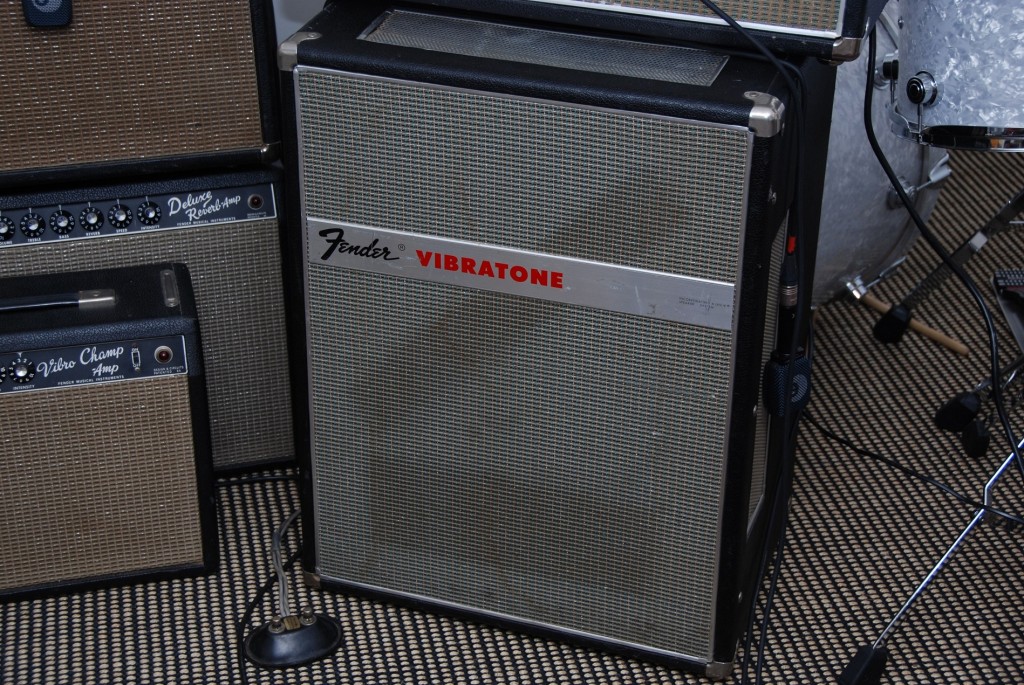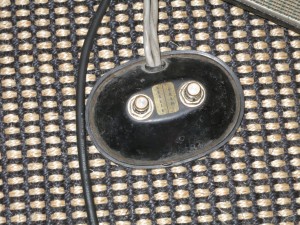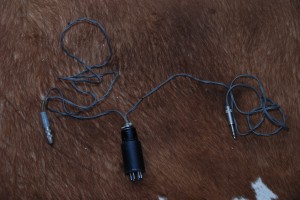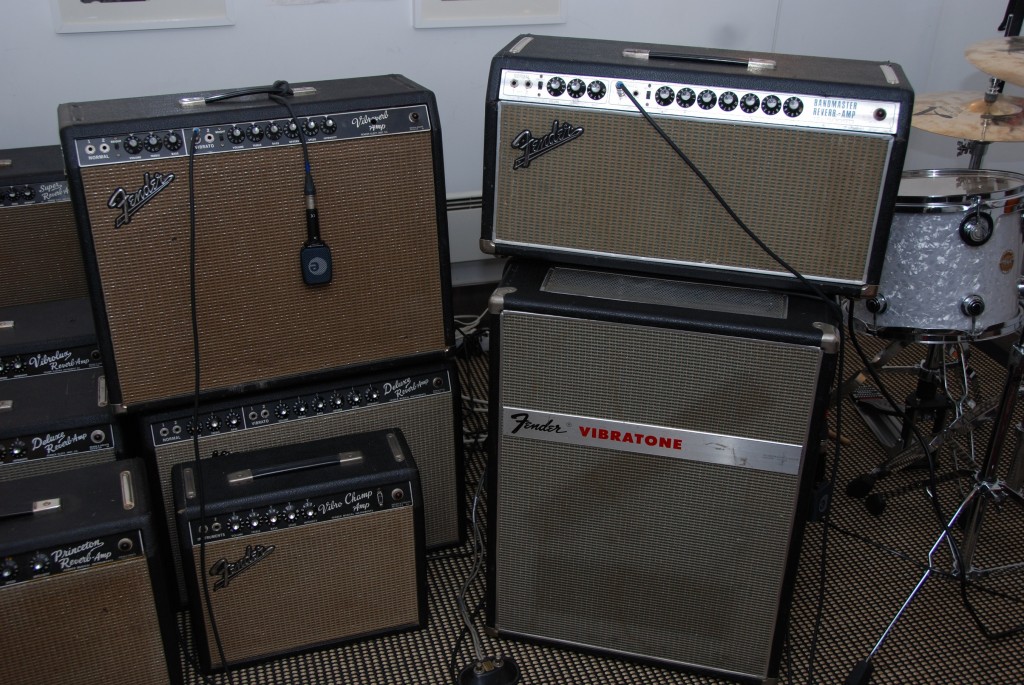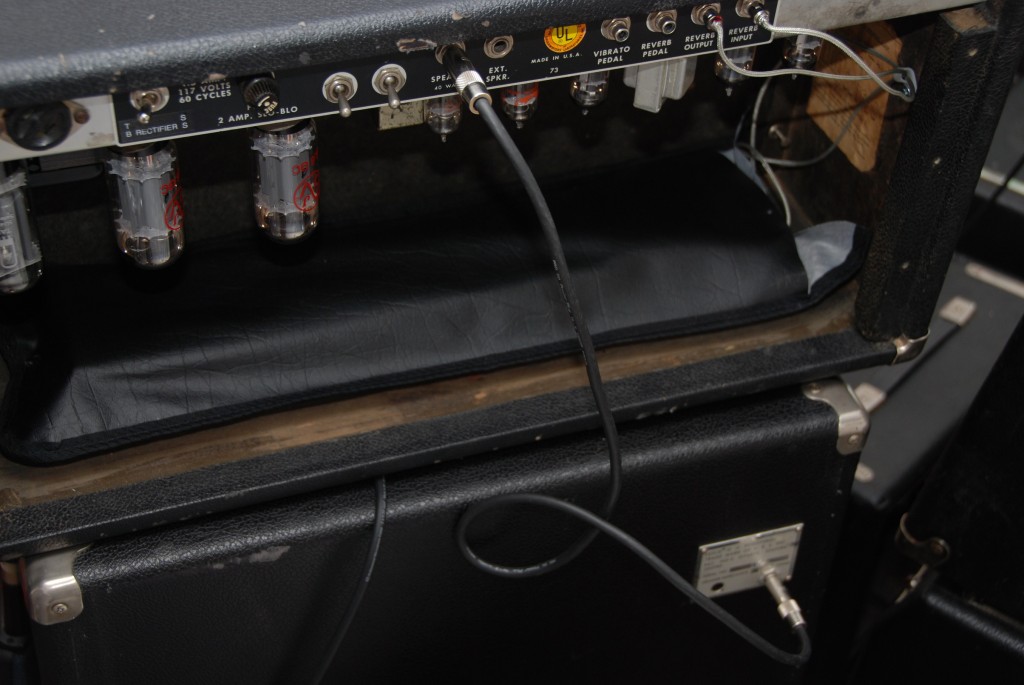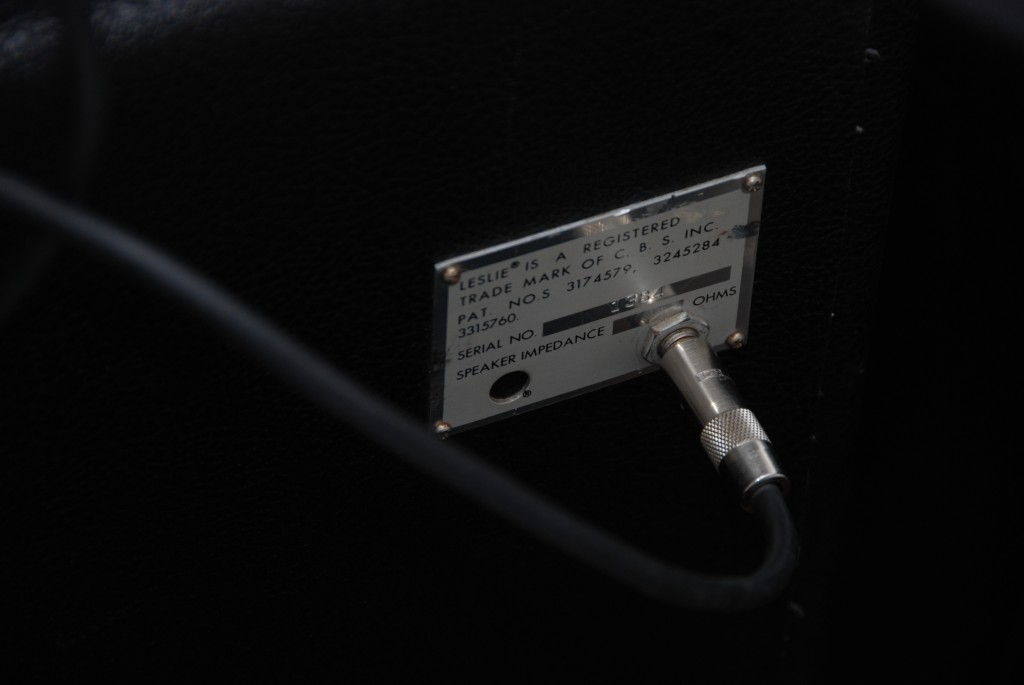Production years
1967 -1968 “blackface” Vibratone
1968 -1972 “silverface” Vibratone
Summary and features
The Fender Vibratone is a variant of the many Leslie speaker cabinets, more famously known as the rotating speakers in Hammond organs. The CBS company who bought Fender in 1965 also owned the Leslie company at that time. They practically set the Fender logo on the Leslie 16 model (+ minor adjustments) and called it a Vibratone. Guitarists could then have inbuilt chorus and vibrato. Before such effect pedals were invented these effects were quite rare.
The Fender Vibratone is a passive speaker cabinet with no inbuilt amp. Inside sits a 4 ohm 100w 10″ Jensen loudspeaker behind a 15-inch rotating styrofoam plate driven by a rotor. The rotor has two speeds, approx 40Hz (slow) and 340 Hz (fast), which will give either a chorus or a vibrato effect. The rotating plate in front of the speaker creates a doppler effect where the frequency is modulated due to redirection of sound waves. The sound waves are reflected when they hit the rotating styrofoam plate and and will exit through the top and both sides. From a fixed observation point the tone will vary in frequency and volume and it will also be experienced differently in various distances and angles from the cabinet.
The Vibratone came with a two-button footswitch that allowed you to 1) switch between slow and fast and 2) enable/disable the Vibratone (volume 10 or 0). There is also a power switch on the back side where you turn the rotor on or off.
The Vibratone had a crossover filter that was built into the wiring harness between the amp and Vibratone cabinet. Its purpose was to prevent the bass and upper treble from entering the Vibratone. It doesn’t need bass or upper treble (see speaker chapter below for more information). If you’re hooking the Vibratone up with i.e. a Vibrolux Reverb via the crossover filter, the Vibratone get the mids while the main speakers of the Vibrolux Reverb gets reduced mids.
The Vibratone is thoroughly described at this fantastic web site: http://www.nmia.com/~vrbass/vibratone. We recommend you read here for a full background history and detailed explanations of the mechanics and physics. We will further explain how to use the Vibratone in your rig to achieve a magnificent tone.
So what does the Vibratone sound like? The video below shows a 1968 Vibratone paired with a 1964 Vibroverb. They are played separately first and then mixed together.
Amp and speaker setup
The inbuilt speaker of the Vibratone is a 100w, 4 ohm Jensen ceramic speaker. Unless you learn a trick from us and bypass the crossover filter, you have to use the included wiring harness and crossover filter to connect to the Vibratone. The Vibratone consist of a closed back cabinet providing a deep bass response. It was designed to function differently from regular speaker cabinets where you have direct line of sight to to the speaker cones (through a grill cloth). The sound waves from the Vibratone loudspeaker is prevented from propagating directly out of the cabinet. The Styrofoam plate is in front of the speaker and it’s uneven shape will redirect the sound waves to certain directions while it rotates. The Vibratone is therefore very inefficient as a speaker cabinet, meaning it does not play loud. In terms of tone it lacks treble but has lots of deep bass due to the closed back construction, which is why the Leslie engineers built the crossover filter. The Vibratone needs only the mids. Filtering out the bass also means less risk of blowing the speaker at higher volumes.
Those who need more volume and clean headroom from the Vibratone can replace the internal Jensen speaker with a highly efficient, modern speaker. A loud NeoDymium speaker is highly recommended because of high power handling, efficiency and low weight. You might also replace the 10″ with a 12″ speaker. Please note that the Vibratone weighs 30-35 kgs already.
There are several ways to run the Vibratone. Let’s mention the basic ones:
- One amp head that runs the Vibratone speaker.
- You’re using the Vibratone as the main speaker cabinet.
- In this mode you have the possibility of switching between slow and fast speed.
- Even with the slow speed, or no rotation at all, you will not get a decent clean sound in our opinion. The tone will be mushy, compressed and with little treble. Some will find it to be a cool or useful tone, but very colored and not like regular speaker cabinets at all. Almost like throwing a carpet around your amp.
- A combo amp that runs both its internal speaker and the Vibratone speaker.
- You’re using the Vibratone as an extension cabinet.
- In this mode you have the possibility to enable or disable the Vibratone with its footswitch, and select rotor speed.
- In this mode you will have to balance the efficiency and impedance between the two speaker cabinets.
- The amp’s volume and EQ settings will be used for both speaker cabinets.
- A primary combo amp + an secondary amp (head) that runs the Vibratone.
- You’re running two separate amps.
- In this mode you have full flexibility. Two separate amps will allow individual volume and EQ control over the Vibratone.
- You may use a AB/Y pedal to select the Vibratone alone, together with main amp or just the main amp. (Or you could use a jack cable from the secondary input of main amp to the input of the secondary amp that runs the Vibratone. This assumes your main amp works like the dual input Fender amps.)
Personally we prefer the last alternative with two separate amps. The picture below shows a 1964 Fender Vibroverb as the main amp and a 1968 Bandmaster Reverb running the Vibratone. The Bandmaster Reverb expects a 4 ohm speaker load and we use it with very little reverb, reduced bass and a high treble setting. On the pedal board we have a AB/Y pedal that allows us to switch between cabinets or use both at the same time. Our effect pedals (wah-wah, overdrive, boost, delay, etc) are only in use for the Vibroverb while the Bandmaster Reverb gets a clean signal from the pedal board. We have not (yet) found any interesting tones combining a lot of effects with the Vibratone. We push the Bandmaster Reverb slightly, volume around 4-5, with a softly cranked tone from the Vibratone. The Vibroverb is set at volume = 3, V1 is pulled and 12Ax7 as V6 phase inverter to lower the clean headroom.
The picture below shows a Bandmaster Reverb running a 4 ohm Fender Vibratone in addition to the two custom inbuilt 8″ speakers. We experienced a nice volume balance by using just one 8″ speaker together with the Vibratone. The Vibratone is very inefficient (not loud) and even if it gets twice as much power as the inbuilt 8″ speaker you will still hear the 8″ speaker.
Bypassing the crossover filter
For our own Vibratone we have implemented a simple mod where we bypass the crossover filter and wiring harness. We have drilled a small hole in the back side of the Vibratone cabinet and installed a jack input allowing us to hook up directly to the speaker. The hole is elegantly drilled through the metal plate and could easily be mistaken for being done by Fender. The reason we do this is that we do not need the crossover filter and nor do we want to use it with the old and messed up wiring harness that requires time and effort when setting up the Vibratone before gigs. Since we use a separate amp for the Vibratone most of the times we can adjust EQ settings on the amp. We have therefore no need for the crossover filter and the old, messed up wiring harness that is about to break any time. We simply use a 60 cm speaker cable between the amp head and Vibratone and flip the main switch of the Vibratone which constantly is set at fast speed, vibrato 340 Hz.
Microphone setup
There are numerous ways to mic up a Vibratone in studio and live. The simplest live setup is to place one microphone on the surface of the top or sides plates where the sound exits the cabinet. A more sophisticated stereo setup requires two microphones, one at each side of the Vibratone, that are panned left and right in the PA. Vibratone left side can be panned 80/20 while the right side is panned (you guessed it) 20/80. If you’re using a main amp additionally to the Vibratone you have to make sure everything is balanced. You would want the Vibratone to come through when it’s enabled, but not twice as loud as the clean sound.

